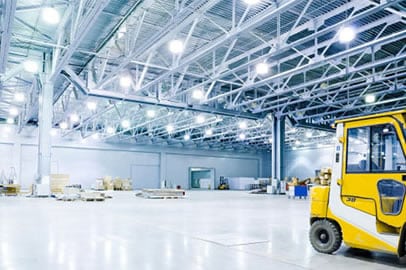As with any decision for your property, it’s a smart idea to investigate all of your options and get a clear picture of what you want from your decision.
Use this guide to explore the facts, advantages, and disadvantages of LED lighting for your home or business so you can make an informed decision.
What is LED Lighting?
Traditional lighting options take the form of incandescent light bulbs, fluorescent bulbs, and compact fluorescent (CFL) lighting. Compared to each of these options, LED lighting offers more lumens, a longer lifespan, and less energy consumption. These reasons are often enough for homeowners or business owners to choose LED technology over another option.
There are many things that set LED lighting apart from other lighting options, particularly in a long list of advantages. From a technical standpoint, LED lighting is produced using a tiny semiconductor light source that is hardly bigger than a grain of salt. It uses a mix of red, green, and blue light to produce that bright white light that has become the hallmark of LED lighting.
Another thing that sets LED apart is its inherent ability to direct light in a particular direction. With other lighting options, the light must be angled in a specific direction or require the use of reflectors or diffusers. This isn’t the case with LED lights, which makes them ideal for a variety of applications.
Something else worth noting is that LEDs emit very little heat. In fact, in most cases, you can turn on an LED light, come back in an hour, and touch it directly without burning your hand. If you’ve ever tried to do the same with an incandescent or CFL bulb, you know that the bulb gets very hot to the touch. When replacing one of these bulbs, you usually have to turn off the light and wait for it to cool so you can safely handle it.
To date, LEDs are being used in a variety of lighting fixtures and applications for homes and businesses. As more consumers learn the advantages of LED lighting, this trend is likely to continue.
12 Advantages of LED Lighting for Homes and Businesses
1. Longer Bulb Life
The Department of Energy’s website states that LED lights typically last up to 25 times longer than incandescent lighting. One way to put this into perspective is to consider how much one incandescent lightbulb costs you, then multiply that by 25. Then, compare that to the cost of just one LED light bulb for the same application.
LED lighting will usually last anywhere from 50,000 hours up to 100,000 hours, which is 2-4 times longer than your average fluorescent, metal halide, or sodium vapor light.
Naturally, the less often you have to replace a bulb, the cheaper your overall maintenance costs become. You’re not spending as much time on labor (if you’re a business owner) to replace burned out lights, and you’re not paying as much to replace light bulbs each year.
2. LED Energy Savings
In comparison to other lighting options, LED lights consume substantially less power, especially when you compare energy usage to its useful lumens production. One report from USA Today noted that switching to LED lighting could save homeowners as much as $1,000 over a 10-year period, which comes out to about $8.33 per month. It’s not going to make you rich, but every little bit helps, especially as energy costs continue to rise.
For businesses and facilities considering a retrofit project to incorporate LED lighting, you’re looking at about a 60%-75% increase in efficiency. This could be quite substantial for business owners, as energy costs for businesses are usually greater compared to that of homeowners.
3. Stronger Lighting Capacity
LEDs tend to give off more light where it’s needed. Part of LED’s efficiency lies in not having to produce as many lumens to create the same desired effect as another lighting option. We measure this by comparing lumens per watt because it illustrates how many watts are required to produce a certain amount of light.
For comparison, a metal halide lamp emitting 34,000 lumens at 400 watts would translate into about 85 lumens per watt. An LED light may average about 140 lumens per watt, meaning it’s producing more lumens for the same amount of energy as the metal halide.
Also, it’s worth mentioning that this doesn’t take into account any energy lost through heat. Because LEDs don’t get “hot” like other lights, all of its energy is being used to power the light. This isn’t the case for fluorescents or incandescent lights, which tend to use up to 80%-90% of their energy as heat.
4. Greater Safety with LED Lighting
Safety isn’t something that most homeowners or business owners think of when choosing lighting, but it should be. LED lighting offers a number of safety advantages over other types of bulbs that can also help to lower their overall costs.
For example, the lack of heat emission can protect you, your family, employees, and customers. If someone were to accidentally touch a bulb or need to change a light, there’s no risk of being burned by the glass.
Another detail that goes overlooked is that LED lights are solid-state lights, which are typically low voltage and very durable. They have no filament that can break and can withstand movement and vibrations.
5. 180-Degree Directional Lighting
We touched on this earlier when defining LED lighting, but it bears repeating: LED lights light in a specific direction and eliminates the need for reflectors and diffusers.
Most lighting will provide 360 degrees of light, which is why it’s so common to see parking lot lights with shades or deflectors to bounce light down to the ground. Without these tools, too much light would be wasted, and not enough light would travel to the desired spot.
This isn’t the case with LED lighting. Because it only lights 180 degrees (a semi-circle), users can lower the cost of their lighting systems by eliminating additional parts that redirect the light.
6. Perfect for Many Applications
Homeowners and business owners alike are finding favor with LED lighting systems. They’re extremely versatile and can provide energy savings and aesthetics just about anywhere you need good lighting.
Some of their popular use cases include, but are not limited to:
- Residences
- Traffic lights and signs
- Retail lighting
- Outdoor lighting for homes, businesses, and municipalities
- Electronic devices
- Vending machines
- Arcades and entertainment venues
We’ll cover more specific use cases for homes and businesses in upcoming sections.
7. Dimming Capabilities with LED Lighting
LED lights can work at any percentage of their capabilities, as long as you’re using a dimmable LED fixture. In other words, you can’t put an LED bulb designed for a dimmable incandescent light and expect it to work.
One advantage of doing this is to increase the efficiency and total lifespan of your LED bulb. They’re already highly efficient, but reducing their power usage makes them even more energy-savvy and can help your lighting to last longer.
This is a huge perk when compared to metal-halide lighting, which becomes less efficient the more it’s dimmed (if it can be dimmed at all).
8. Environmental Friendliness
LEDs are generally seen as the environmentally friendly lighting choice for many reasons. For starters, there’s no mercury inside the bulb that could pose environmental or safety hazards when broken or disposed of. Lighting that contains mercury requires special disposal once the product has reached the end of its life, but that’s not the case with LED light bulbs.
And because of its energy efficiency, it doesn’t require as much power, which is also good for the planet. Less power means fewer greenhouse gases produced, so you can feel good about your investment in a whole new way.
9. Structurally Sturdy
When you think of light bulbs, you often picture a glass bulb with a filament or other components inside. They’re also considered to be fragile items that, if dropped, will likely shatter into tiny pieces.
LED lights, however, are sturdier than your average light bulb. LED lights use a semiconductor instead of gas or a filament and are enclosed in epoxy rather than a glass bulb, which gives them greater structure and sturdiness. Depending on the specific LED lights (such as holiday lights or recessed lighting), you may find that the glass bulb has been traded for a plastic one that makes it less messy and dangerous if you drop it.
They also produce zero UV emissions, which make them an ideal choice for lighting sensitive items like art that might degrade over time when exposed to UV rays.
10. Multiple Color Options
Like other types of lights, LED lighting can be purchased in a variety of temperatures. Whether you want a warm yellow glow or a cool white light, there’s an LED bulb for you. They’re also a popular choice when you want to jazz up a room with colored lights, which usually come in the form of single bulbs, light strips, fairy string lights, remote-controlled lighting, and holiday lights.
11. Greater Design Flexibility
LEDs work for a variety of different settings and applications in a multitude of formats, giving you more flexibility in your design. You can use them for string lights on your outdoor patio or recessed lighting in your kitchen. Put them in a spotlight for an art gallery or use them to light your storefront or driveway.
There are tons of LED-friendly fixtures in a variety of shapes, sizes, and styles. If you’re wanting to create a special aesthetic, LEDs are a great bet.
12. Not Attractive to Insects
Something that homeowners might rejoice over is the fact that LEDs might be less attractive to bugs. It’s not a guarantee, but for the most part, bugs don’t enjoy LED lights because they do not emit heat or UV rays, both of which bugs love.
This isn’t to say that your LED lights will repel bugs, as that’s never the case. However, if you turn on an LED light and place it beside another light source outside, chances are more bugs will flock to the other light source. LEDs could be an excellent way to reduce any uninvited guests to your backyard get-togethers.
Are There Disadvantages to LED Lighting?
When exploring lighting options for your home or business, it’s important to look for the full story and not just focus on the benefits. While the list of advantages of LED lighting is significantly longer than its disadvantages, there are a few potential downsides you should consider.
For starters, purchasing LED lights requires more of an upfront investment compared to traditional lights. The cost is offset by the savings you get on your energy bill and the longer lifespan of each light, but those are benefits that come over time. You’ll still need to budget for more upfront, which is something that many homeowners and business owners don’t consider at first.
Something else to keep in mind is that some LEDs may exceed safe levels of blue light emittance. Too much blue light can interfere with sleep cycles, create light pollution, and may cause damage to the retina. This isn’t the case with all LEDs, so it’s a good idea to work with a professional who knows how to choose LED lights to ensure you select the best ones.
Also, remember that we mentioned LEDs give off 180 degrees of directional light, which is fine if you don’t require a spherical light source. If you do need more coverage (up, down, and all around), then LED lighting might not be the best option.
Use Cases for LED Lighting at Home
For homeowners that are currently building a new home or want to upgrade the lighting in an existing home, LED is an easy choice. This hasn’t always been the case, however, as it was mostly commercial properties that were using LED. However, manufacturers have made affordable LED lighting solutions and fixtures for residential purposes, and the trend is catching on among Texas homeowners.
Some of the areas you might consider using LED lighting include but are not limited to:
- Closets, hallways, and other dim spaces
- Under-cabinet or over-cabinet kitchen lighting
- Over the sink light fixtures
- Outdoor lighting, including string lights for patios or wall-mounted fixtures
- Color-changing “mood” lighting strips or bulbs
- Ceiling lights
- Pendant lights over a bar
- Floor lamps and table lamps
- Decorative LED lighting behind an entertainment center or headboard
- Battery-powered LED lights inside drawers
- Pantry lighting (strip lighting works well here)
- Bathroom vanity lights
- Shower lights
- Home offices
- Wall spotlights for art
- Nightstands
- Reading lights
- Garages or workshops

Use Cases for LED Lighting for a Business
Some of the best applications of LED lighting in local businesses we’ve seen include:
- Multicolored exterior lighting for hotels
- Under-bar lighting for bars and restaurants
- LED lighting to color wash walls
- Outdoor patio lighting for restaurants and bars
- Display cabinets
- Exhibitions, trade shows, and vendor booths
- Clean office lighting for glare-free computer screens
- Stair lighting
- Outdoor lighting
- Ballrooms and convention centers
- Company signage
- Wine racks and beer coolers
Whether you have a company that’s open to the public or owns a private office, LED lighting is an awesome choice for businesses.
How to Choose the Right LED Lighting
Choosing LED lighting is the first step. From there, it’s a matter of considering the logistics, including placement, fixture type, budget, and installation.
There are countless ways to use LED lighting in your business or home, and we’re here to provide you with inspiration and expertise to ensure an optimal outcome. If you’re ready to switch to LED lighting for residential or commercial applications, contact our team for a consultation.










Recent Comments